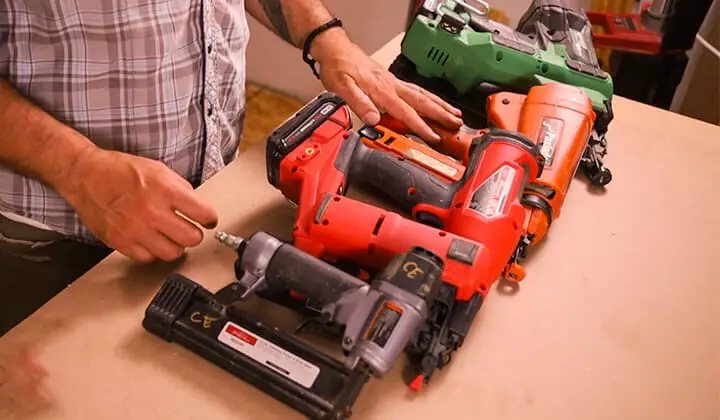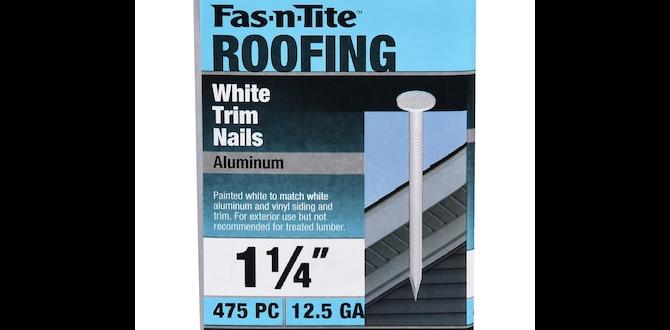Though 15 and 16 gauge nail guns are more popular, that’s not what kills every bird. The more the gauge size, the less the thickness of the nail. That’s how your nail gun gauge chart goes.
If you want to know about the gauge sizes of all nail guns, a nail gun gauge chart is the one you should look for. I’ve prepared a rather shorthanded and effective one for you. The augmentation of their corresponding uses will just boost your deciding drive. You can find your desired nail gun easily by glancing at it.

Table of Contents
Nail Gauge Size Chart (Common Nail Size Chart)
| Penny Size | Nail Gauge | Shank Diameter (Official) | Shank Length (Official) | Head Diameter (Approx.) |
| 2D | 15 | 0.072 | 1” | 3/16” |
| 2D | 14 | 0.083 | 1” | 13/64” |
| 3D | 14 | 0.083 | 1.25” | 13/64” |
| 4D | 12 | 0.109 | 1.5” | 1/4” |
| 5D | 12 | 0.109 | 1.75” | 1/4″ |
| 6D | 11 | 0.120 | 2” | 17/64” |
| 8D | 10 | 0.134 | 2.5” | 9/32” |
| 10D | 9 | 0.148 | 3” | 5/16” |
| 12D | 9 | 0.148 | 3.5” | 5/16” |
| 16D | 8 | 0.165 | 4” | 11/32” |
| 20D | 6 | 0.203 | 4.5” | 13/32” |
| 30D | 5 | 0.220 | 5” | 7/16” |
| 40D | 4 | 0.238 | 6” | 15/32” |
| 60D | 4 | 0.238 | 6” | 17/32” |
| 60D | 2 | 0.284 | 6″ | 17/32” |
Nail Gauge Size Chart (Box and Thread Nails)
| Penny Size | Nail Gauge | Shank Diameter (Official) | Shank Length (Official) | Head Diameter (Approx.) |
| 3D | 14-1/2 | 0.076 | 1.25” | 3/16” |
| 4D | 14 | 0.080 | 1.5” | 13/64” |
| 5D | 14 | 0.080 | 1.75” | 13/64” |
| 6D | 12-1/2 | 0.098 | 2” | 1/4” |
| 6D | 12-1/2 | 0.12 | 2” | 1/4″ |
| 7D | 12-1/2 | 0.098 | 2.25” | 17/64” |
| 8D | 11-1/2 | 0.113 | 2.5” | 9/32” |
| 8D | 11-1/2 | 0.12 | 2.5” | 5/16” |
| 10D | 10-1/2 | 0.128 | 3” | 5/16” |
| 10D | 10-1/2 | 0.135 | 3” | 11/32” |
| 12D | 3-1/4 | 0.135 | 3.25” | 13/32” |
| 16D | 10 | 0.135 | 3.5” | 7/16” |
| 16D | 10 | 0.148 | 3.5” | 15/32” |
| 20D | 9 | 0.148 | 4” | 17/32” |
| 20D | 6 | 0.177 | 4” | 17/32” |
| 30D | 5 | 0.177 | 4.5” | 7/16″ |
| 40D | 4 | 0.177 | 5” | 15/32″ |
| 50D | 3 | 0.177 | 5.5” | 15/32″ |
| 60D | 2 | 0.177 | 6” | 17/32″ |
| 70D | 2 | 0.207 | 7” | 17/32″ |
| 80D | 1 | 0.207 | 8” | 15/32″ |
| 90D | 1 | 0.207 | 9” | 17/32″ |
Nail Gun and Gauge Size Chart
| Nail Gun | Size (Gauge) | Poplar Usages |
| Brad Nailer | 18 gauge | nailing slim baseboards |
| Finish Nailer | 16, 15, and 14 gauge | baseboards, crown molding, window and door casings, chair rails, nailing thick baseboards, etc. |
| Pin Nailer | 21 and 23 gauge | furniture trimming, trim pieces, super-thin veneers, etc. |
| Staple Nailer | 18 gauge | fastening molding and trimming to walls |
| Flooring Nailer | 15, 16, 18, and 20 gauge | hardwood flooring |
| Roofing Nailer | 10, 11, and 12 gauge | nailing roof shingles |
Different Types of Nail Guns and Nail Gauges
There are six types of nail guns you can buy according to the nail gauge chart. Most of them use different sizes and kinds of the nail for nailing purposes.
1. Brad Nailer
Among the nail guns, a brad nail gun is one of the most versatile nail guns. It is a beginner-friendly nailer. Because it is not heavy like other nail guns and also does accurate nailing.
Primarily used in interior works like assembling cabinets, and baseboards, Brad Nailers uses very tiny nails that are very thin and flimsy. If you look at the 18 gauge Brad nail size chart you’ll find that the nail will easily bend if you try to nail it with a hammer.
18 Gauge
Brad nailer uses only 18 gauge nails which are small and thin. It fastens the nails about 5/8” to 2” and leaves the shanks about 3/64”. As it is a thin nail, you can use it to nail slim baseboards.

2. Finish Nailer
A Finish nailer is used for finishing products in indoor household projects like paneling and bookshelf nailing. It can shoot nails about ¾” to 2-1/2” long pins. And it mainly uses 14, 15, and 16 gauge nails.
If you look at the nail gun nail size chart, you will find that the Finish nail gauge chart indicates that the nails are thicker, even the head diameters. Although they are strong and sturdy, they are visible to the open eye and you need to use nail concealers to hide them.
16 Gauge and 15 Gauge
15 and 16 gauge nails work in baseboards, crown molding, window and door casings, chair rails, etc. The only difference between them is in shank diameter. Sixteen gauge nails have a shank of 0.0625 inches, whereas 15 gauge have .0720 inches.

16 gauge finish nailer

15 gauge finish nailer
14 Gauge
14 gauge are thick nails that find their use more in heavy projects. You will need a thick and robust pin like a 14 gauge nail to hold the heavy products firmly. It leaves a shank about .0800 inches in diameter.
3. Pin Nailer
Pin nail guns are for trimming work. A pin nailer leaves a tiny hole in the woods or materials you are nailing. The nail has no head like other nails, so you don’t need to fill the small gaps. According to gauge size, there are two types of pin nailers.
21 Gauge
In a 21 gauge nail gun, the nail shank diameter is 0.0285 inches. This is why it is sometimes called a Micro Brad nail. Generally, it is used in beading and molding.
23 Gauge
In a 23 gauge nail gun, the nail shank diameter is 0.0226 inches. 23 gauge nails are one of the tiniest nails on the market and are often used in small wooden projects. It is also use headless nails in pin nail guns.

4. Staple Nailer
Staple nailer works to hold the materials firmly. Like a brad nailer, it also doesn’t split the wood when you nail them.
18 Gauge Crown Stapler
18 gauge narrow crown stapler fastens the wood using 18 gauge stapler nails. As the stapler nails have double legs, it lasts longer than a single leg pin. Stapler nail guns are mainly for functioning trumps forming projects.

5. Flooring Nailer
The flooring nailer uses both a stapler and nails. But it won’t grip the board and do the subfloor, which is a good thing.
15, 16, 18, or 20 Gauge
They have a sharp tip, a rigid body, and a smooth shank to allow little seasonal movement. As they are available in 15, 16, 18, or 20 gauge nail sizes, they can be used in various applications.
They fire nails in angles and deep into the tongue’s corner and through into the subfloor. Once you set the nail gun, you can work for a very long time.

6. Roofing Nailer
If you want to do a roofing project related to woodwork, you must use a roofing nailer. A roofing nail gun uses 3 kinds of the nail to nail down asphalt shingles of roofs.
10, 11, or 12 Gauge
There are three kinds of nails for roofing nail guns in 10, 11, 12-gauge. If you want to nail your roofing shingles or cedar shingles, you can use a 12 gauge roofing nailer.
[aawp box=”B07M79PN4H” template=”vertical”]
Importance of Nail Gun Gauge Chart
You have to know the nail gun gauge chart before you are buying your nail guns. It is imperative to know your nail gun before you press the trigger. You may use the wrong size nailer in your projects. The nail gun gauge guides you to the right nail every time.
Frequently Asked Questions
- What does gauge mean in nail guns?
Gauge in nail guns means what diameter of the nail can be used by the gun. The higher the diameter the thinner the nail. And lower diameter means thicker nails. This is why different nail guns require different nail sizes. Knowing the nail gauge size chart helps you with this easily.
- Can I use 18 gauge nails for baseboards?
Yes, you can use18 gauge nails for baseboards. Looking at the 18 gauge nail gauge chart, you can tell 18 nails are thin in size. So they can not nail down thick woods or baseboards. But if you are using a narrow baseboard, then you can use 18 gauge nails.
- What is the difference between a 15 gauge and 16 gauge nail gun?
15 gauge and 16 gauge nail guns can fire nails up to 2 1/2 inches (6D to 8D long nails). One of the main differences is the diameter of the pin, where the 15 gauge is more prominent, and the angled base of the 15 gauge nailer that helps you reach corners easily.
- Should I get a 16 gauge or 18 gauge nailer?
A 16 gauge nailer shoots thicker nails than an 18-gauge nailer. 16 gauge is better suited for jobs that require higher stability and better holding strength.
In most cases, the 16 gauge does a better job than the much thinner 18 gauge. Also, the 16 gauge delivers smoother and cleaner work than the 18 gauge nail gun.
- What size finishing nail should I use?
Finishing nails are used for thicker wood that is used as baseboards, crown molding, windows, chair rails and so much more. The finishing nail gauge chart tells you that the nails are 14,15 and 16 gauges. Which have a head diameter of 13/64” to 3/16” according to the nail diameter chart. This ensures the sturdy grip between the layers of wood and wall or anything that you are nailing the wood into.
Lastly
A nail gun gauge chart can work as a nail gauge guide to give you a glimpse of the guns in the market and their nails. Indeed, you don’t need to memorize all the nailers. As we suggest, molding and trimming require thinner nails. But fencing and roofing ask for a sturdier means. Thus you just need to make sure to use the right nail gun in your work.





Can a nail gun use a 34° and a 30° nail?
Can I use 30° nails in a 34° gun. Hard to find 34° nails. Thanks
Charts very helpful!